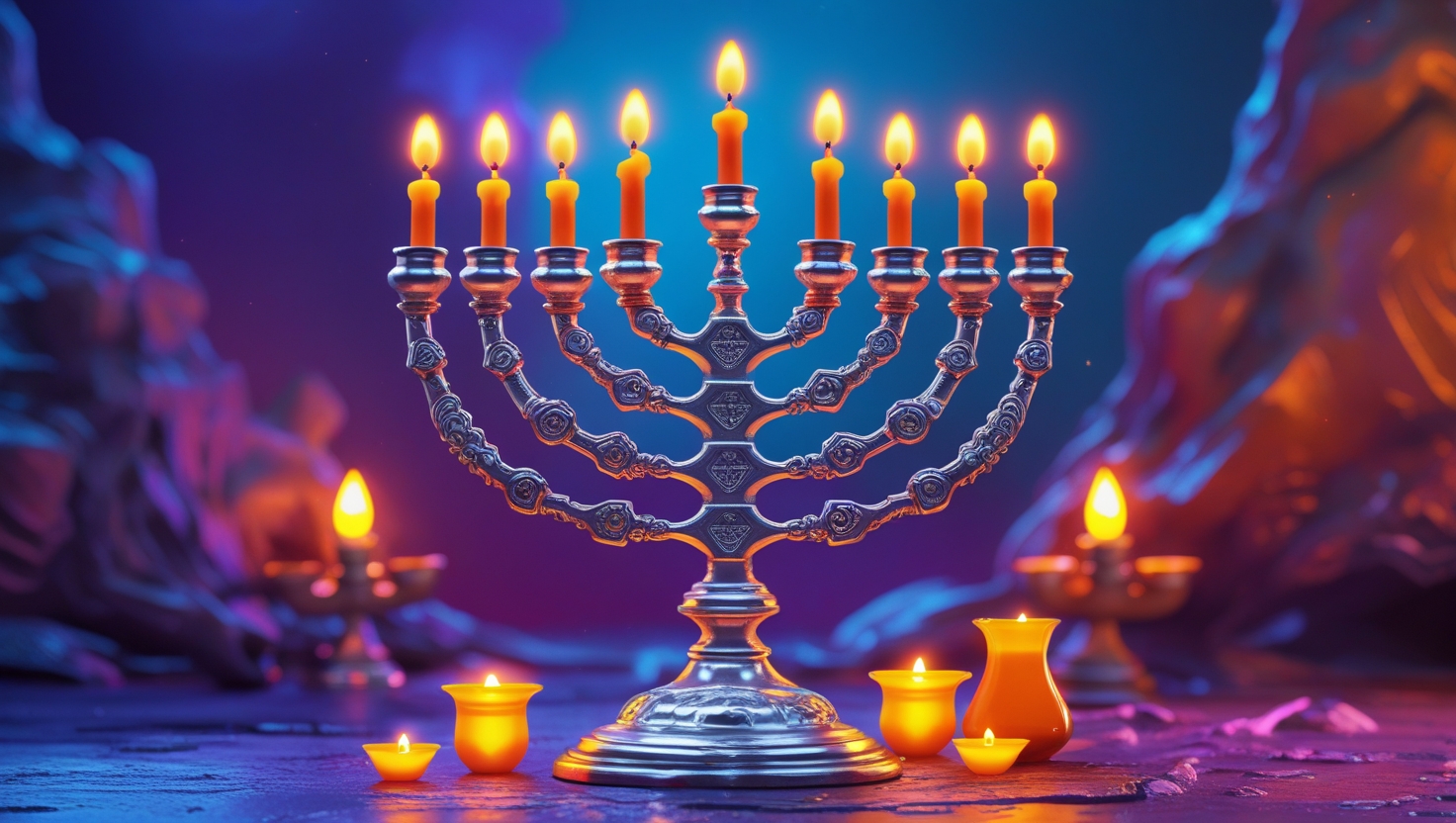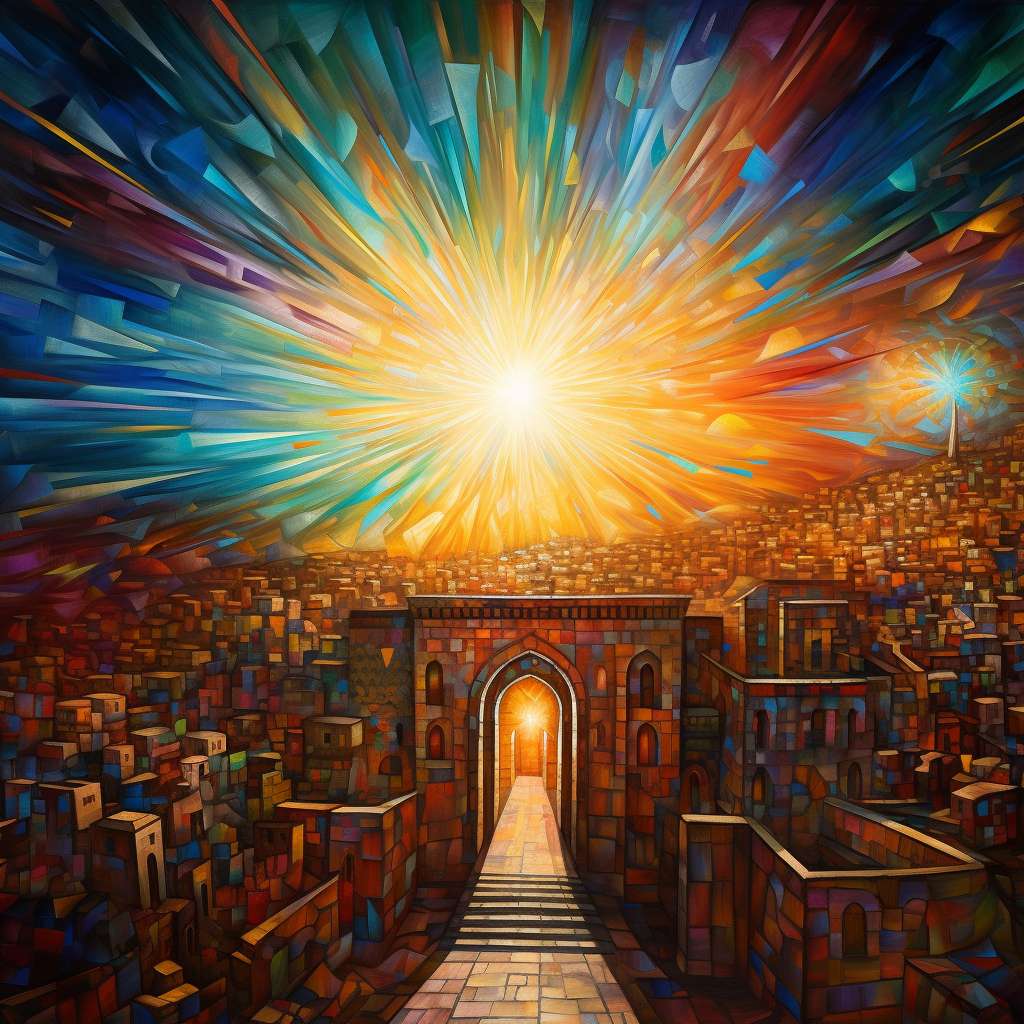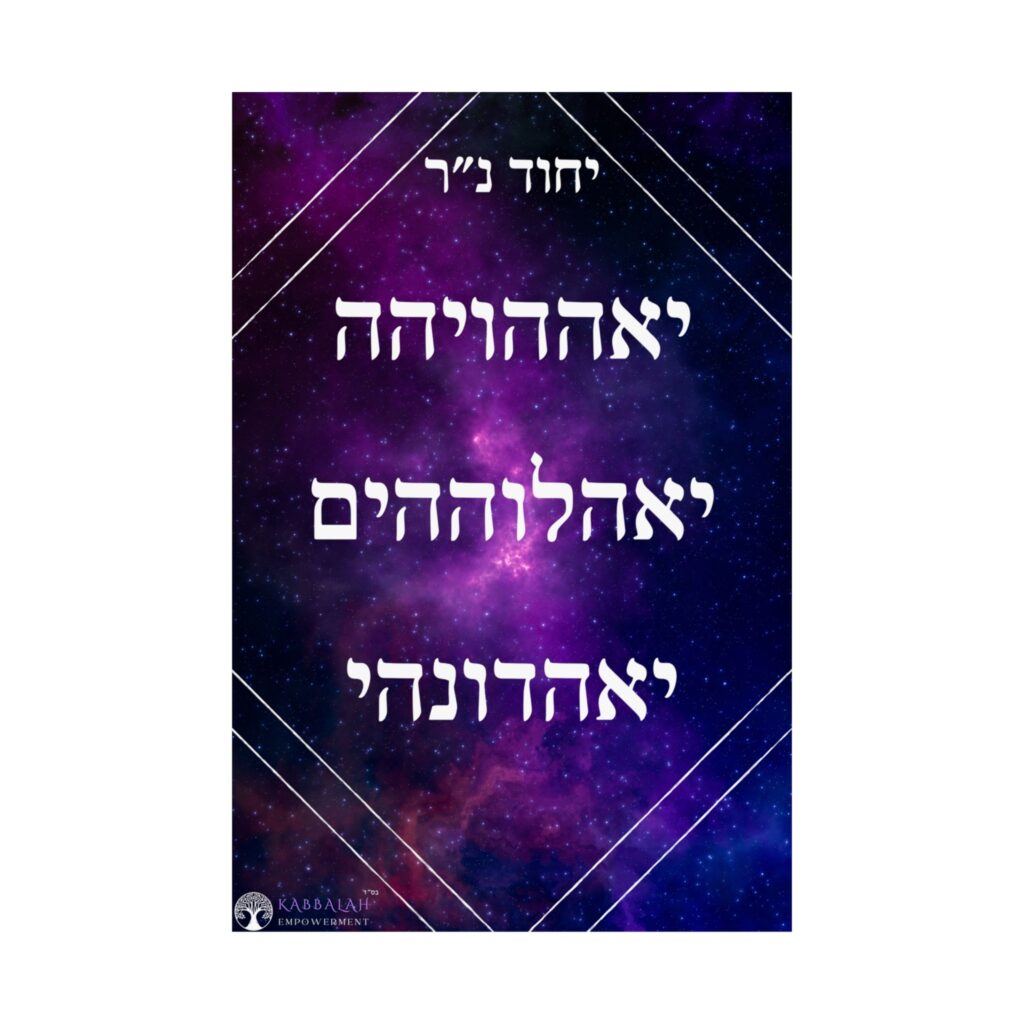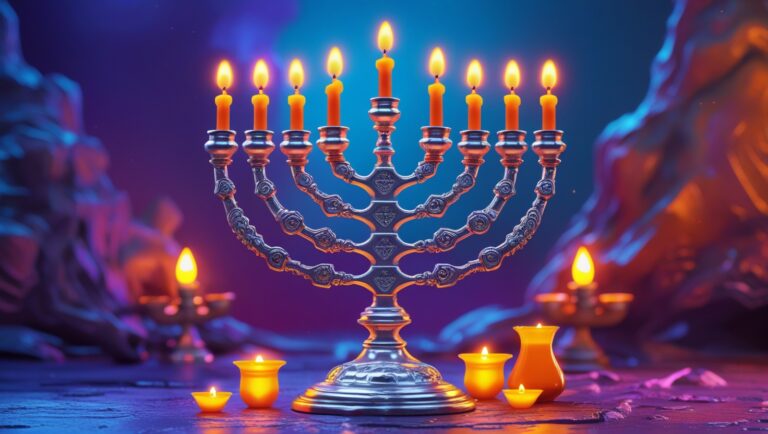As we all know, Kislev is the 3rd month of the year, and Chanuka falls on its 25th day
In Sha’ar HaKavanot we find that on Rosh Hashanah, the judgment is written, on Yom Kippur, the first seal (of Yesod) is done, and on Hoshana Rabbah, the second seal (of Malkhut) is done. After then, the petakim (notes) are dispatched with the angels in charge of executing them whether for good or otherwise. The Ramchal writes that “they don’t feel at rest until they fulfill their mission”. After that, even though it’s still possible to do Teshuva and annul a decree, it’s much more difficult.
Interestingly enough though, the Baal Shem Tov used to say that there’s still a small opening for a person to do Teshuva up until the 25th of Kislev, which is the first day of Chanuka. The source is the verse from Tehilim (90:3) in which is written “Tashev Enosh Ad Daka”. The literally meaning is that Hashem brings a person close (“returns him”) to a breaking point (“Daka”). The Baal Shem Tov, however, interprets Daka (דכא) which has a Gematria of 25 as referring to the 25th of Kislev, first day of Chanuka.
It’s a well-recognized principle that during a Jewish month hosting a specific festival, the atmosphere is distinctly shaped by that celebration. Linked to the Sephirah of Tiferet (beauty), this month stands as the male counterpart to Sivan, the time of Shavuot.
This connection has some striking meaning, as beauty is more than a superficial quality; in a spiritual context, it represents the harmonious balance between the forces of benevolence (chassadim) and judgment (gevurot), yielding a harmonious outcome. In essence, it mirrors the satisfaction derived from witnessing the fruits of our labor, akin to the appreciation of the land’s bounty following the offering of the Omer on Shavuot.
As we approach the incredibly powerful month of Kislev (or are inside of it already) in which Chanuka falls, we should prepare ourselves, both physically and mentally in order to make the most out of it.

The Zohar on the festivals
The Zohar divides the festivals in many different ways. As with everything in Kabbalah, it much depends on which perspective we are using when analyzing a given concept.
The Rashash and Arizal use the following one to teach which Partzuf (spiritual system) we are rectifying in each of the festivals, according to the order of Sephirot:
- Chesed: Pesach and Omer
- Gevurah: Rosh Hashanah, Yom Kippur, Sukkot, Shmini Atzeret
- Tiferet: Shavuot and Omer
- Netzach: Purim
- Hod: Chanuka
- Yesod: Tu B’Shvat
- Ateret (the crown) HaYesod: Tu B’Av
- Malkhut: Tisha B’Av
While we don’t have time now to discuss each of them, we see that Chanuka is the rectification of the Partzufim of Hod. According to the Rashash we are specifically rectifying all the Partzufim of A”K (Adam Kadmon) and A”BYA (Atzilut, Beriyah, Yetzirah and Assiyah) of Hod of the Partzuf HaZemanim (the “festivals'” Partzuf).
During Chanuka we should feel tremendous appreciation for having been rescued from Hellenization and the attempts to destroy us spiritually. In Halacha, we therefore hold special meals which are considered “Seudot Mitzvah” only when we sing praises and thank Hashem for the miracles he made.
The attribute of “Hod” (splendor) is most revealed when are humble and in awe of something. This was indeed the first time in Jewish history we were actually willing to die for the Torah. It’s also noteworthy that many Rabbis teach us that part of the war was specifically aimed at Jews who had been so assimilated as to become part of the enemy army.
We therefore recognize in great awe, that it was thanks to Hashem that Matityahu received proper leadership and an overwhelming victory against the brutal and professional Syrian Greek army with all its war machine.
The miracle with the oil, while meaningful and very powerful, should be completely obscured by the awesome victory this army of Torah scholars had upon trained warriors and traitors of all sorts. Indeed, this victory was nothing less than the Shekhina vesting itself into the Jewish army and guiding them toward liberation. For that though, Mattityahu, his sons and comrades made use of holy names
A few secrets of Kislev and Chanuka
Kislev (כסלו), a fusion of “Kis” (כס) and “Lev” (לו), unfolds intriguing layers of significance. The term “Kis” transforms into “throne/chair” (כסא), incorporating the addition of alef with a numerical value of 1, a permissible modification in Gematria. Simultaneously, “Lev” carries a numerical value of 36, symbolizing the 36 concealed tzaddikim or the 36 candles kindled during Chanukah, excluding the Shamash. These are the Tzadikim that sustain the world with their merits.
Yet, לו, when read as לב (heart), by substituting the Vav for a Vet, points to the love for Hashem experienced in this month. Another facet of “Kis” materializes in its alternative spelling כיס, denoting a purse or wallet, a positive anticipation of sustenance.
The teachings of the Arizal shed light on Chanukah’s unique essence. In contrast to Purim, lacking a Talmud Tractate, Chanukah emanates from the Sephirah of Hod (splendor), diverging from Purim rooted in Netzach (victory, or eternity), complete with the dedicated Tractate Megillah. However, being that Chanukah is marked by the recitation of the entire Hallel and an 8-day celebration, this light permeates the atmosphere of Kislev, foretelling the blessings ahead.
As the sages say in the Talmud “all festivals will be annulled in the future, except for Purim”. This is because Purim is rooted in Netzach, which also means “eternity”.
Balance in Jewish Life
True peace arises from the delicate equilibrium of opposing forces. It manifests when we find the middle ground between diligent toil and essential repose, personal striving and Emunah (faith), giving and receiving embracing the harmony within any dichotomy.
Our observance of Mitzvot and dedicated Torah study guides us toward a life illuminated by balance. The directive dictates six days of labor and a day of comprehensive rest. It admonishes against both overindulgence and self-mortification. While we are encouraged to savor the pleasures of this world, the reminder persists that our ultimate aim is the Olam HaBah (World to Come).
The essence of balance is encapsulated in the term “Izun” (איזון), intricately linked to “Ozen” (אוזן), meaning “ear”. Notably, during Kislev, we rectify the “left ear” of the divine providence’s male spiritual aspect, often referred to as “Ze’ir Anpin” in Kabbalah. Our sages teach that the “ears bring balance” to an individual.
This wisdom extends further, as the “ear” aligns with the sense of “hearing,” an attribute of the Sephirah of “Binah” (Understanding) “coincidentally” associated with Chanukah as well. Understanding, kind of like hearing, involves assembling disparate fragments of information into a coherent whole.
The reason is that the 8 candles of Chanukah symbolize the 8 Sephirot. If we count from above, we reach Hod. If we count from below, we reach Binah.

Kavanot of Chanukah
On Chanukah the 13 attributes of mercy are shinning and we can draw down this powerful light with the kavanot. These are the lights of the “beard” of Arich Anpin which vest themselves in Imma (Binah), and then go down to Malkhut from Atzilut to be bestowed upon us.
There’s a double Kavanah here for the 13 attributes of mercy:
First: On each of the 8 days of Chanukah we meditate on each one of the 13 Attributes as follows:
- Day 1, attribute 1: אל (“El”, the great)
- Day 2 attribute 2: רחום (“Rachum”, the compassionate)
- Day 3 attribute 3: וחנון (“V’Chanun”, the graceful)
- Day 4 attribute 4: ארך (“Erech”, slow [to anger])
- Day 5 attribute 5: אפים (“Apaim”, long [suffering])
- Day 6 attribute 6: ורב חסד (“V’Rav Chessed”, great to bestow kindness)
- Day 7 attribute 7: ואמת (“V’Emet”, truthful)
- Day 8 Zot Chanukah – Attributes 8-13:
- Attribute 8: נוצר חסד (“Notzer Chessed”, keeper of kindness)
- Attribute 9: לאלפים (“La’alafim”, for thousands of generations)
- Attribute 10: נושא עוון (“Nosse Avon”, withholds sins)
- Attribute 11: ופשע (“Va’Fesha”, and rebellion)
- Attribute 12: וחטאה (“V’Chata’ah”, and unintentional sins)
- Attribute 13: ונקה (“V’Nakeh”, and cleanses)
Second: On the first Bracha, we say each of the words having in mind one of the attributes as follows:
- Baruch – attribute 1: אל (“El”, the great)
- Atah – attribute 2: רחום (“Rachum”, the compassionate)
- Ado-nai – attribute 3: וחנון (“V’Chanun”, the graceful)
- Elo-heinu – attribute 4: ארך (“Erech”, slow [to anger])
- Melekh – attribute 5: אפים (“Apaim”, long [suffering])
- HaOlam – attribute 6: ורב חסד (“V’Rav Chessed”, great to bestow kindness)
- Asher – attribute 7: ואמת (“V’Emet”, truthful)
- Kidshanu – Attribute 8: נוצר חסד (“Notzer Chessed”, keeper of kindness)
- B’Mitzvotav – Attribute 9: לאלפים (“La’alafim”, for thousands of generations)
- V’Tzivanu – Attribute 10: נושא עוון (“Nosse Avon”, withholds sins)
- L’Hadlik – Attribute 11: ופשע (“Va’Fesha”, and rebellion)
- Ner – Attribute 12: וחטאה (“V’Chata’ah”, and unintentional sins)
- Chanuka – Attribute 13: ונקה (“V’Nakeh”, and cleanses)
The first letters of the last 3 words of the Bracha (L’hadlik Ner Chanukah) also spell out the holy name of Hashem נח״ל which is good to be Mekaven at that time. This is why the Sephardic Siddurim omit the word “shel” (של, “of”) of the blessing, to keep it with 13 words.
It’s also very powerful to keep in mind throughout Chanukah, and especially after the first blessing to have the Yichud meditation of the Ner (“Candle”) in which we unite the 3 names of Hashem EHYH, ELO-HIM and ADO-NAI interwoven with YHVH.
The Ner Meditation:

Concluding remarks
In Kislev, just like its female counterpart Sivan, we are afforded a peek into the accomplishments stemming from Rosh Hashanah. Things begin to take shape and physicality. It is a time of tremendous grace which we must strive our best to make the most out of it.
Chanukah is a time when we can bring down the miracles we need. As we enter the month of Kislev, let’s be happy in the realization that Hashem is extending to us this extraordinary chance to serve Him with such a simple Mitzvah of lighting the Chanukah candle that has awesome power to counter darkness.
May the outcomes of our efforts be visible both in this world and the world to come!







